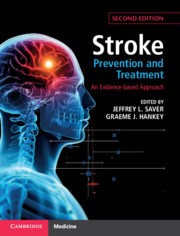Book contents
- Stroke Prevention and Treatment
- Stroke Prevention and Treatment
- Copyright page
- Dedication
- Contents
- Contributors
- Preface
- Part I Foundations
- Part II Systems of Care
- Chapter 3 Prehospital Stroke Care and Regionalized Stroke Systems
- Chapter 4 Organized Stroke Care
- Part III Acute Treatment of Ischaemic Stroke and Transient Ischaemic Attack
- Part IV Acute Treatment of Haemorrhagic Stroke
- Part V Prevention
- Part VI Stroke Rehabilitation and Recovery
- Index
- References
Chapter 4 - Organized Stroke Care
from Part II - Systems of Care
Published online by Cambridge University Press: 15 December 2020
- Stroke Prevention and Treatment
- Stroke Prevention and Treatment
- Copyright page
- Dedication
- Contents
- Contributors
- Preface
- Part I Foundations
- Part II Systems of Care
- Chapter 3 Prehospital Stroke Care and Regionalized Stroke Systems
- Chapter 4 Organized Stroke Care
- Part III Acute Treatment of Ischaemic Stroke and Transient Ischaemic Attack
- Part IV Acute Treatment of Haemorrhagic Stroke
- Part V Prevention
- Part VI Stroke Rehabilitation and Recovery
- Index
- References
Summary
Most patients with suspected stroke should be transported without delay to a hospital, which has access to the required diagnostic tests and appropriate hyperacute treatments 24 h/day and 7 days/week. Once admitted, patients should be managed in a stroke unit rather than a general medical ward. There appears to be no systematic increase in length of hospital stay associated with organized (stroke unit) care. The recent development of hyperacute stroke units is not based on evaluation within RCTs but appears to improve processes of care in the acute phase. Processes of care on a stroke unit should mirror those found to be effective in RCTs. Stroke care should be specialized, organized, and multidisciplinary (i.e. provided by medical, nursing, physiotherapy, occupational therapy, speech therapy, and social work staff who are interested and trained in stroke care). The other beneficial components of organized stroke care are likely to be many, but it remains uncertain which are the most effective. Early discharge from the stroke unit with support from a domiciliary rehabilitation team (coordinated by the stroke unit) promises to reduce hospital length of stay and improve rehabilitation in the home and patient outcome.
Keywords
- Type
- Chapter
- Information
- Stroke Prevention and TreatmentAn Evidence-based Approach, pp. 59 - 76Publisher: Cambridge University PressPrint publication year: 2020



